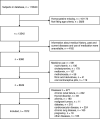Gender- and age-related differences in homocysteine concentration: a cross-sectional study of the general population of China
- PMID: 33060744
- PMCID: PMC7566483
- DOI: 10.1038/s41598-020-74596-7
Gender- and age-related differences in homocysteine concentration: a cross-sectional study of the general population of China
Abstract
The primary goals of this study were to evaluate the gender- and age-related differences in homocysteine concentration in the general population of China and possible influencing factors. A total of 7872 subjects, divided into male and female groups, participated in this retrospective study. The average homocysteine level, prevalence of hyperhomocysteinemia, and independent factors affecting homocysteine concentration were analyzed. The homocysteine level was significantly higher in males than in females in each age range (aged 20-30, aged 30-40, aged 40-50, aged 50-60, aged 60-80, aged over 80) (P < 0.0001), and the trend did not abate with age. The homocysteine concentration first decreased and then increased, being lowest at 30-50 years of age and significantly increased after 50 years of age. Factors associated with homocysteine concentration in males were smoking status (current smokers versus ex-smokers: β: 0.112), estimated glomerular filtration rate (β = - 0.192), blood urea nitrogen (β = - 0.14), diastolic blood pressure (β = - 0.113), free triiodothyronine (β = - 0.091), serum potassium (β = - 0.107) and cystatin C (β = 0.173). In females, independent factors associated with homocysteine concentration were cystatin C (β = 0.319), albumin (β = 0.227), free thyroxine (β = 0.179), age (β = 0.148), free triiodothyronine (β = - 0.217) and serum potassium (β = - 0.153). The homocysteine level was significantly higher in males than in females and increased markedly after 50 years of age in both groups. The independent factors associated with increased homocysteine concentration differed between males and females.
Conflict of interest statement
The authors declare no competing interests.
Figures




References
MeSH terms
Substances
LinkOut - more resources
Full Text Sources

